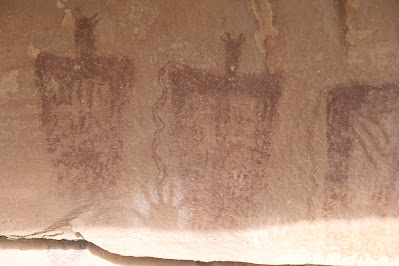
Round Trip Distance: 1.2 miles
Difficulty: Easy
Elevation: 4765 - 4802 feet
Cellphone: 0 bars
Time: 1 hr. 45 mins.
Trailhead: Colorado River Overlook Rd.
Fee: $30/vehicle
Attractions: pictographs
The White Bird Shelter is one mile north of the Visitor Center in the Needles District of Canyonlands National Park near Monticello, Utah. The site includes numerous Barrier Canyon Style (BCS) anthropomorphic images, painted hands and the eponymous image of a 'White Bird'.
The simplest directions for getting there are to enter the 'Needles District of Canyonlands' into your driving app and follow its turn-by-turn directions to the Visitor Center. (There is no cellphone service so download the directions for offline access.)From the north end of the parking lot follow the Colorado River Overlook Road. Depending on road conditions the gate may be closed. If the conditions are too muddy to drive they probably aren't much better for walking.
There are 3 places to park and use for a trailhead. Two of them are outlined with short lengths of wood and seem more official. We parked at a third pull off where there were already a good number of tire tracks. You can be assured that the Park Service will not take kindly to blocking the road or creating any new pull offs.
The trick to getting to the White Bird Shelter is in getting around the part of the Lower Salt Creek Wash that is choked with invasive saltcedar and other brush. The first two, or more official trailheads, provide a place from which to start to get around the south end of the tangle where you can then cut across the barren ground to get to the shelter. We chose to go around the north end of the brush barrier where we followed the grassy bed of the wash until we could skirt around the cliffs. While we did see plenty of fresh deer and bighorn scat there was nothing else to recommend the route.
The shelter itself is tucked away beneath the overhanging brow of a short southeast facing sandstone cliff.
Beginning at the west end of the shelter there is a large square headed anthropomorphic image and a good number of painted hands.
The entire overhang stretches out for approximately 70 feet. The White Bird image is on the ceiling of the overhang, near the outer edge, directly in front of a large panel of painted hands.
The well placed image of the White Bird, soaring overhead, still shows up pretty well on the soot stained surface of the shelter.
On the wall beneath the White Bird image is a large panel of painted hands. The painted hands seem to denote a change in the use of the White Bird Shelter. Most of the hands are superimposed over other images and even the soot covered walls showing that they were made at a later date than the BCS anthropomorphic images.
Most of the hands are of the sprayed paint negative handprint type but several stylized handprints also occur. A few of the stylized handprints on separate panels were done with red paint. It might be that both the red and white paint stylized images date around the same period as the BCS anthropomorphic images or at least predate the negative handprints.
Displayed at the east end of the White Bird Shelter is a gallery of BCS images. The ten images in the top row are far from vivid but still mostly discernible. Beneath that row is another of mostly washed out images.
A very interesting commonality is that most of them have the same style of head that resembles that of a bighorn sheep.
In some aspects the head looks a bit like a cross between a bighorn sheep and a deer. If you zoom in and look closely at some of the heads you can make out the eyes and the snout. The long slender neck is also very fitting.
This trio make up the far right hand side of the upper row of images.
The bottom row of images has suffered the same demise as any panel where the images are closer to the ground. At that location they receive not only more direct sunlight, which fades the paint, but the rock itself gets dissolved by rain mixed with both atmospheric acids and ground minerals. In areas where cattle were allowed to graze it is common for the animals to seek shelter beneath overhangs like this and rub up against the images although there doesn't appear to be a manure layer at this site.
When the photos for this post were taken we were experimenting with a new full frame camera and several different lenses. We probably should have also packed along our old reliable camera and used that also. At some point when we are once again in the neighborhood we'll have to see if we can't get better photos. As far as the White Bird Shelter goes, if you would like to see it for yourself all you have to do is 'Take a hike'.
When the photos for this post were taken we were experimenting with a new full frame camera and several different lenses. We probably should have also packed along our old reliable camera and used that also. At some point when we are once again in the neighborhood we'll have to see if we can't get better photos. As far as the White Bird Shelter goes, if you would like to see it for yourself all you have to do is 'Take a hike'.


















